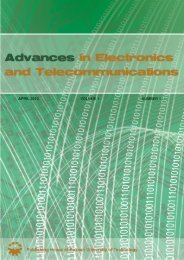november 2010 volume 1 number 2 - Advances in Electronics and ...
november 2010 volume 1 number 2 - Advances in Electronics and ...
november 2010 volume 1 number 2 - Advances in Electronics and ...
Create successful ePaper yourself
Turn your PDF publications into a flip-book with our unique Google optimized e-Paper software.
62 ADVANCES IN ELECTRONICS AND TELECOMMUNICATIONS, VOL. 1, NO. 2, NOVEMBER <strong>2010</strong><br />
Fig. 1. Evolution of the first-order soliton (N = 1) over one soliton period.<br />
the core, then the optimal value of the normalized frequency<br />
Vopt ofthemodeledstep<strong>in</strong>dexfiberisalso<strong>in</strong>creas<strong>in</strong>g.Increase<br />
of Vopt implies <strong>in</strong>crease of zero dispersion wavelength λZD<br />
<strong>and</strong> cut off wavelength λC, which are equal <strong>in</strong> case of<br />
normalized frequency optimization. Additionally, growth of<br />
Vopt value is responsible for rise of the average power curried<br />
by the core P1. There is only one more parameter which<br />
value is <strong>in</strong>creas<strong>in</strong>g when mol % dop<strong>in</strong>g of germaniumdioxide<br />
is <strong>in</strong>creas<strong>in</strong>g. It is nonl<strong>in</strong>ear parameter γ, which <strong>in</strong> turn is<br />
responsible for decreas<strong>in</strong>g the peak power needed to generate<br />
fundamental soliton <strong>in</strong> each case of step <strong>in</strong>dex fiber model<strong>in</strong>g<br />
process. Furthermore, decrease of dispersion parameter D<br />
<strong>and</strong> absolute value of group velocity dispersion parameter<br />
β2 is responsible for <strong>in</strong>crease of dispersion length LD <strong>and</strong><br />
value of the soliton period z0. Fundamental disadvantage<br />
of <strong>in</strong>creas<strong>in</strong>g λZD <strong>and</strong> λC is decreas<strong>in</strong>g of bright soliton<br />
generation region ∆λZD <strong>and</strong> s<strong>in</strong>gle mode operation region<br />
∆λC, which are essential <strong>in</strong> wavelength division multiplex<strong>in</strong>g<br />
technique application.<br />
REFERENCES<br />
[1] G. P.Agrawal, Nonl<strong>in</strong>ear Fiber Optics, third edition ed. Academic Press,<br />
2001.<br />
[2] ——, Applications of Nonl<strong>in</strong>ear Fiber Optics. Academic Press, 2001.<br />
[3] ——, Fiber-Optic Communication Systems. John Wiley & Sons, 2002.<br />
[4] E. Iannone, F. Matera, A. Mecozzi, <strong>and</strong> M. Settembre, Nonl<strong>in</strong>ear Optical<br />
Communication Networks. John Wiley & Sons, 1998.<br />
[5] G. Keiser, Optical Fiber Communications. McGraw-Hill, 1991.<br />
[6] A. Majewski, Teoria i projektowanie ´Swiatłowodów. WNT, Warszawa,<br />
1991, (<strong>in</strong> Polish).<br />
[7] M. J. Adams, An Introduction to Optical Waveguides. John Wiley &<br />
Sons, 1981.<br />
Tomasz Kaczmarek received the M.Sc. degree <strong>in</strong> electrical eng<strong>in</strong>eer<strong>in</strong>g from<br />
Kielce University of Technology <strong>in</strong> 1994 <strong>and</strong> the Ph.D. degree <strong>in</strong> electronic<br />
eng<strong>in</strong>eer<strong>in</strong>g from Warsaw University of Technology <strong>in</strong> 2002. Currently he<br />
is the Head of Laboratory of Optical Fiber Technology of the Institute of<br />
Telecommunication, Photonics <strong>and</strong> Nanomaterials at the Kielce University of<br />
Technology. He authored <strong>and</strong> co-authored over 30 publications. His current<br />
research <strong>in</strong>terests <strong>in</strong>clude fiber optics <strong>and</strong> nonl<strong>in</strong>ear fiber optics.







